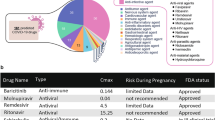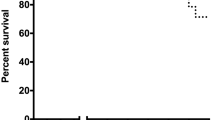Abstract
We have recently established that human norovirus (HuNoV) replicates efficiently in zebrafish larvae after inoculation of a clinical sample into the yolk, providing a simple and robust in vivo system in which to study HuNoV. In this Protocol Extension, we present a detailed description of virus inoculation by microinjection, subsequent daily monitoring and harvesting of larvae, followed by viral RNA quantification. This protocol can be used to study viral replication of genogroup (G)I and GII HuNoVs in vivo within 3–4 d. Additionally, we describe how to evaluate the in vivo antiviral effect and toxicity of small molecules using HuNoV-infected zebrafish larvae, in multi-well plates and without the need for specific formulations. This constitutes a great advantage for drug discovery efforts, as no specific antivirals or vaccines currently exist to treat or prevent norovirus gastroenteritis.
This is a preview of subscription content, access via your institution
Access options
Access Nature and 54 other Nature Portfolio journals
Get Nature+, our best-value online-access subscription
$29.99 / 30 days
cancel any time
Subscribe to this journal
Receive 12 print issues and online access
$259.00 per year
only $21.58 per issue
Buy this article
- Purchase on Springer Link
- Instant access to full article PDF
Prices may be subject to local taxes which are calculated during checkout









Similar content being viewed by others
References
Bartsch, S. M., Lopman, B. A., Ozawa, S., Hall, A. J. & Lee, B. Y. Global economic burden of norovirus gastroenteritis. PloS ONE 11, e0151219 (2016).
Jones, M. K. et al. Enteric bacteria promote human and mouse norovirus infection of B cells. Science 346, 755–759 (2014).
Ettayebi, K. et al. Replication of human noroviruses in stem cell-derived human enteroids. Science 353, 1387–1393 (2016).
Van Dycke, J. et al. A robust human norovirus replication model in zebrafish larvae. PLoS Pathog. 15, e1008009 (2019).
Cheetham, S. et al. Pathogenesis of a genogroup II human norovirus in gnotobiotic pigs. J. Virol. 80, 10372–10381 (2006).
Souza, M., Azevedo, M. S., Jung, K., Cheetham, S. & Saif, L. J. Pathogenesis and immune responses in gnotobiotic calves after infection with the genogroup II.4-HS66 strain of human norovirus. J. Virol. 82, 1777–1786 (2008).
Taube, S. et al. A mouse model for human norovirus. mBio https://doi.org/10.1128/mBio.00450-13 (2013).
Sullivan, C. et al. Using zebrafish models of human influenza A virus infections to screen antiviral drugs and characterize host immune cell responses. J. Vis. Exp. https://doi.org/10.3791/55235 (2017).
Harvie, E. A. & Huttenlocher, A. Non-invasive imaging of the innate immune response in a zebrafish larval model of Streptococcus iniae infection. J. Vis. Exp. https://doi.org/10.3791/52788 (2015).
Mazon Moya, M. J., Colucci-Guyon, E. & Mostowy, S. Use of Shigella flexneri to study autophagy-cytoskeleton interactions. J. Vis. Exp. https://doi.org/10.3791/51601 (2014).
Howe, K. et al. The zebrafish reference genome sequence and its relationship to the human genome. Nature 496, 498–503 (2013).
Aleström, P. et al. Zebrafish: housing and husbandry recommendations. Lab Anim. https://doi.org/10.1177/0023677219869037 (2019).
Costantini, V. et al. Human norovirus replication in human intestinal enteroids as model to evaluate virus inactivation. Emerg. Infect. Dis. 24, 1453–1464 (2018).
Takaki, K., Davis, J. M., Winglee, K. & Ramakrishnan, L. Evaluation of the pathogenesis and treatment of Mycobacterium marinum infection in zebrafish. Nat. Protoc. 8, 1114–1124 (2013).
Saydmohammed, M. & Tsang, M. High-throughput automated chemical screens in zebrafish. Methods Mol. Biol. (Clifton, N.J.) 1683, 383–393 (2018).
Gray, C. et al. Simultaneous intravital imaging of macrophage and neutrophil behaviour during inflammation using a novel transgenic zebrafish. Thromb. Haemost. 105, 811–819 (2011).
Willis, A. R. et al. Shigella-induced emergency granulopoiesis protects zebrafish larvae from secondary infection. mBio 9, e00933–00918 (2018).
Miskolci, V. et al. Distinct inflammatory and wound healing responses to complex caudal fin injuries of larval zebrafish. eLife 8, e45976 (2019).
Burgos, J. S., Ripoll-Gomez, J., Alfaro, J. M., Sastre, I. & Valdivieso, F. Zebrafish as a new model for herpes simplex virus type 1 infection. Zebrafish 5, 323–333 (2008).
Gabor, K. A. et al. Influenza A virus infection in zebrafish recapitulates mammalian infection and sensitivity to anti-influenza drug treatment. Dis. Model. Mech. 7, 1227–1237 (2014).
Palha, N. et al. Real-time whole-body visualization of Chikungunya virus infection and host interferon response in zebrafish. PLoS Pathog. 9, e1003619 (2013).
Wilson, C. Aspects of larval rearing. ILAR J. 53, 169–178 (2012).
Gore, A. V., Pillay, L. M., Venero Galanternik, M. & Weinstein, B. M. The zebrafish: a fintastic model for hematopoietic development and disease. Wiley Interdiscip. Rev. Dev. Biol. 7, e312–e312 (2018).
Goody, M. F., Sullivan, C. & Kim, C. H. Studying the immune response to human viral infections using zebrafish. Dev. Comp. Immunol. 46, 84–95 (2014).
Kanther, M. & Rawls, J. F. Host-microbe interactions in the developing zebrafish. Curr. Opin.Immunol. 22, 10–19 (2010).
Lewis, K. L., Del Cid, N. & Traver, D. Perspectives on antigen presenting cells in zebrafish. Dev. Comp. Immunol. 46, 63–73 (2014).
Lister, J. A., Robertson, C. P., Lepage, T., Johnson, S. L. & Raible, D. W. nacre encodes a zebrafish microphthalmia-related protein that regulates neural-crest-derived pigment cell fate. Development 126, 3757–3767 (1999).
Karlsson, J., von Hofsten, J. & Olsson, P. E. Generating transparent zebrafish: a refined method to improve detection of gene expression during embryonic development. Mar. Biotechnol. 3, 522–527 (2001).
Stals, A. et al. Multiplex real-time RT-PCR for simultaneous detection of GI/GII noroviruses and murine norovirus 1. J. Virol. Methods 161, 247–253 (2009).
Kageyama, T. et al. Broadly reactive and highly sensitive assay for Norwalk-like viruses based on real-time quantitative reverse transcription-PCR. J. Clin. Microbiol. 41, 1548–1557 (2003).
Balla, K. M., Rice, M. C., Gagnon, J. A. & Elde, N. C. Linking virus discovery to immune responses visualized during zebrafish infections. Curr. Biol. 30, 2092–2103.e2095 (2020).
Giusti, A. et al. Safety assessment of compounds after in vitro metabolic conversion using zebrafish eleuthero embryos. Int. J. Mol. Sci. https://doi.org/10.3390/ijms20071712 (2019).
Acknowledgements
We very much appreciate the expert technical assistance and dedication of J. Rymenants, L. Bervoets and J. Maes. We thank the KU Leuven aquatic facility for breeding the zebrafish larvae. We thank the pediatrics department and the CEMOL Molecular Diagnostic department of the University Hospital of Leuven for the collaboration. J.V.D. and the research leading to these results has received funding from the Scientific Fund for Research of Flanders (FWO) as an SB doctoral fellow. A.C. is supported by internal funding from the KU Leuven.
Author information
Authors and Affiliations
Contributions
Designed experiments: J.V.D., A.C., S.R., S.T., J.R.-P. Performed experiments: J.V.D., A.C., J.K. Analyzed data: J.V.D., A.C., J.K., S.T., J.R.-P. Supervised the experiments: A.N., P.d.W., S.T., J.N., J.R.-P. Wrote manuscript: J.V.D., A.C., S.T., J.R.-P. Graphs: J.V.D., A.C., J.K., S.T., J.R.-P. Figures and videos: A.C., J.V.D. All authors reviewed and edited the protocol.
Corresponding author
Ethics declarations
Competing interests
The authors declare no competing interests.
Additional information
Peer review information Nature Protocols thanks Jean-Pieere Levraud and the other, anonymous, reviewer(s) for their contribution to the peer review of this work.
Publisher’s note Springer Nature remains neutral with regard to jurisdictional claims in published maps and institutional affiliations.
Related links
Key references using this protocol
Van Dycke, J. et al. PLoS Pathog. 15, e1008009 (2019): https://doi.org/10.1371/journal.ppat.1008009
Takaki, K. et al. Nat. Prot. 8, 1114–1124 (2013): https://doi.org/10.1038/nprot.2013.068
This protocol is an extension to: Nat. Protoc. 8, 1114–1124 (2013): https://doi.org/10.1038/nprot.2013.068
Supplementary information
Supplementary Video 1
Clipping of the microinjection needle
Supplementary Video 2
Correct size bolus
Supplementary Video 3
Microinjection in the yolk of 3 dpf zebrafish larvae
Supplementary Video 4
Dechorionation of 2 dpf zebrafish larvae
Supplementary Video 5
Microinjection in the pericardial cavity of 3 dpf zebrafish larvae
Rights and permissions
About this article
Cite this article
Van Dycke, J., Cuvry, A., Knickmann, J. et al. Infection of zebrafish larvae with human norovirus and evaluation of the in vivo efficacy of small-molecule inhibitors. Nat Protoc 16, 1830–1849 (2021). https://doi.org/10.1038/s41596-021-00499-0
Received:
Accepted:
Published:
Issue Date:
DOI: https://doi.org/10.1038/s41596-021-00499-0
Comments
By submitting a comment you agree to abide by our Terms and Community Guidelines. If you find something abusive or that does not comply with our terms or guidelines please flag it as inappropriate.



